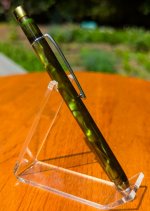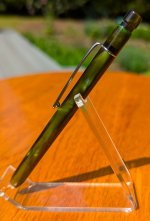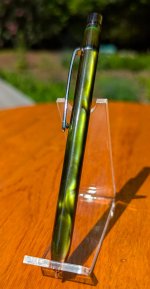duncsuss
Member
A few years ago I had the good fortune to acquire some gorgeous vintage celluloid rods, but at 11mm diameter they aren't really large enough to make fountain pens. I made one into a ballpoint using the Schmidt SKM-88 mechanism (it sold quickly), then set them aside to focus on fountain pens. Eventually I got back to them - this time trying the Schmidt SKM-192 mechanism. It's a bit trickier because you have to make the housing for it (3 or 4 different drill diameters, plus internal tapping, plus a threaded tenon to screw into the end of the barrel, plus a button to glue onto the stem - where the SKM-88 has all of that stuff ready made.) I like the end result better, but I'm sure that some people would prefer the chrome button.
Anyway - here's the first one in a pretty green celluloid. I've started another in blue material before I forget the sequence of steps



Anyway - here's the first one in a pretty green celluloid. I've started another in blue material before I forget the sequence of steps



